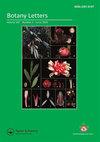Plant-based extracts for cotton pest management in Sub-Saharan Africa: a review
IF 1.3
4区 生物学
Q3 PLANT SCIENCES
引用次数: 3
Abstract
ABSTRACT Cotton crops are hampered by a complex of arthropod species, insects and mites that attack all plant organs. In sub-Saharan Africa, crop pest control mainly involves synthetic pesticide applications based on a treatment calendar consisting of 5–6 applications at 14-day intervals. Organic cotton production chains have however been set up to supply a niche market, with botanical extracts used for crop protection. This review presents published results of experiments conducted in sub-Saharan African countries. A total of 37 plant species were laboratory tested in research stations (24 trials) and village fields in Central and West African countries. Neem (Azadirachta indica) was the plant most commonly used in the form of seed-pressed oil. In Mali, this compound was combined with Carapa procera oil in organic cotton cropping conditions. Cassia nigricans is another species reported to be used in Mali, Burkina Faso and Benin. Aromatic species such as Ocimum gratissimum, Cymbopogon citratus, Citrus sp. were also tested. Further research could focus on species such as Anacardium occidentale and Hyptis suaveolens, which seem to be locally available. The use of essential oils does not appear to take priority over aqueous extracts, which could be tested in crop protection programmes involving partial substitution of synthetic insecticides.撒哈拉以南非洲棉花病虫害治理的植物提取物:综述
摘要棉花作物受到节肢动物、昆虫和螨虫等复杂物种的阻碍,这些物种会攻击所有植物器官。在撒哈拉以南非洲,作物病虫害防治主要涉及基于处理日历的合成农药施用,该处理日历包括每隔14天施用5-6次。然而,有机棉生产链的建立是为了提供一个利基市场,植物提取物用于作物保护。这篇综述介绍了在撒哈拉以南非洲国家进行的实验的已发表结果。在中非和西非国家的研究站(24个试验)和乡村田地里,共对37种植物进行了实验室测试。印楝(Azadirachta indica)是最常用的榨油形式的植物。在马里,这种化合物与Carapa procera油在有机棉花种植条件下结合。黑决明是据报道在马里、布基纳法索和贝宁使用的另一种物种。还测试了香辛、香茅、柑桔等芳香品种。进一步的研究可以集中在像Anacardium occidentale和Hyptis suaveolens这样的物种上,这些物种似乎在当地可以买到。精油的使用似乎并不优先于水提取物,水提取物可以在涉及部分替代合成杀虫剂的作物保护方案中进行测试。
本文章由计算机程序翻译,如有差异,请以英文原文为准。
求助全文
约1分钟内获得全文
求助全文
来源期刊

Botany Letters
Agricultural and Biological Sciences-Plant Science
CiteScore
3.10
自引率
6.70%
发文量
54
期刊介绍:
Botany Letters is an international scientific journal, published by the French Botanical Society (Société botanique de France) in partnership with Taylor & Francis. Botany Letters replaces Acta Botanica Gallica, which was created in 1993, building on over a century of renowned publications by the Société botanique de France.
 求助内容:
求助内容: 应助结果提醒方式:
应助结果提醒方式:


